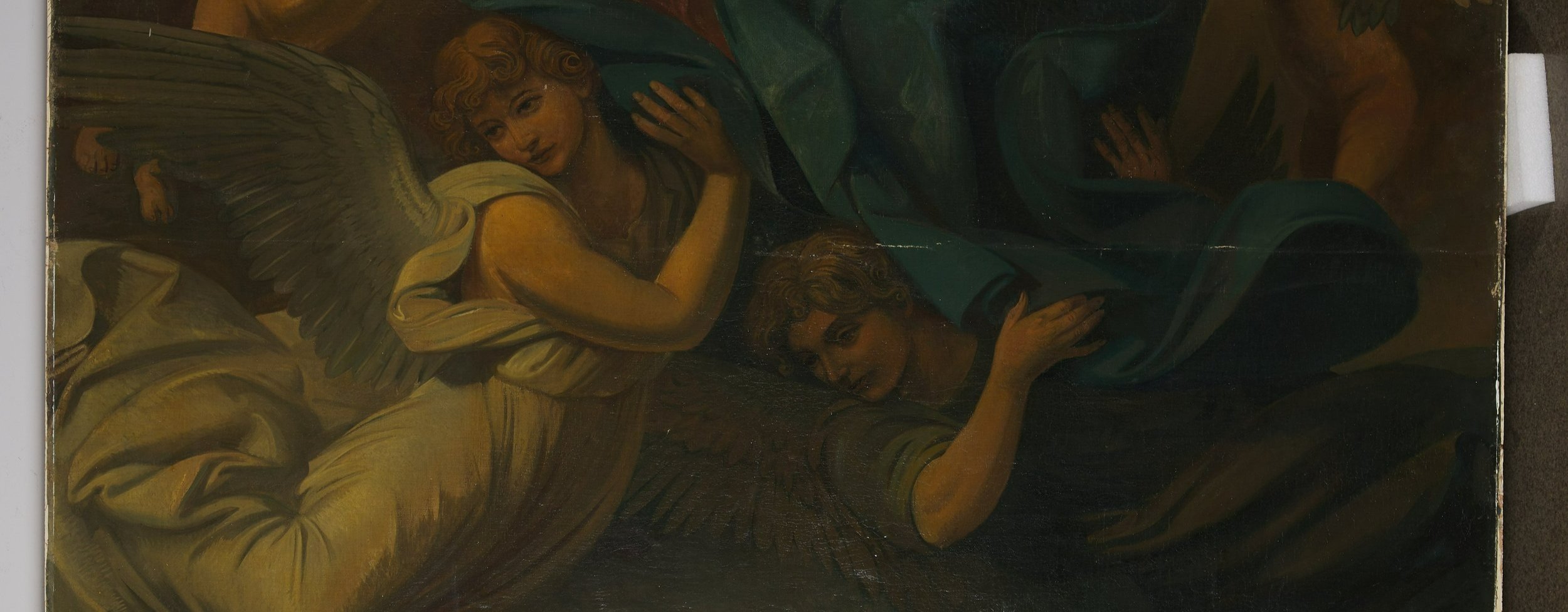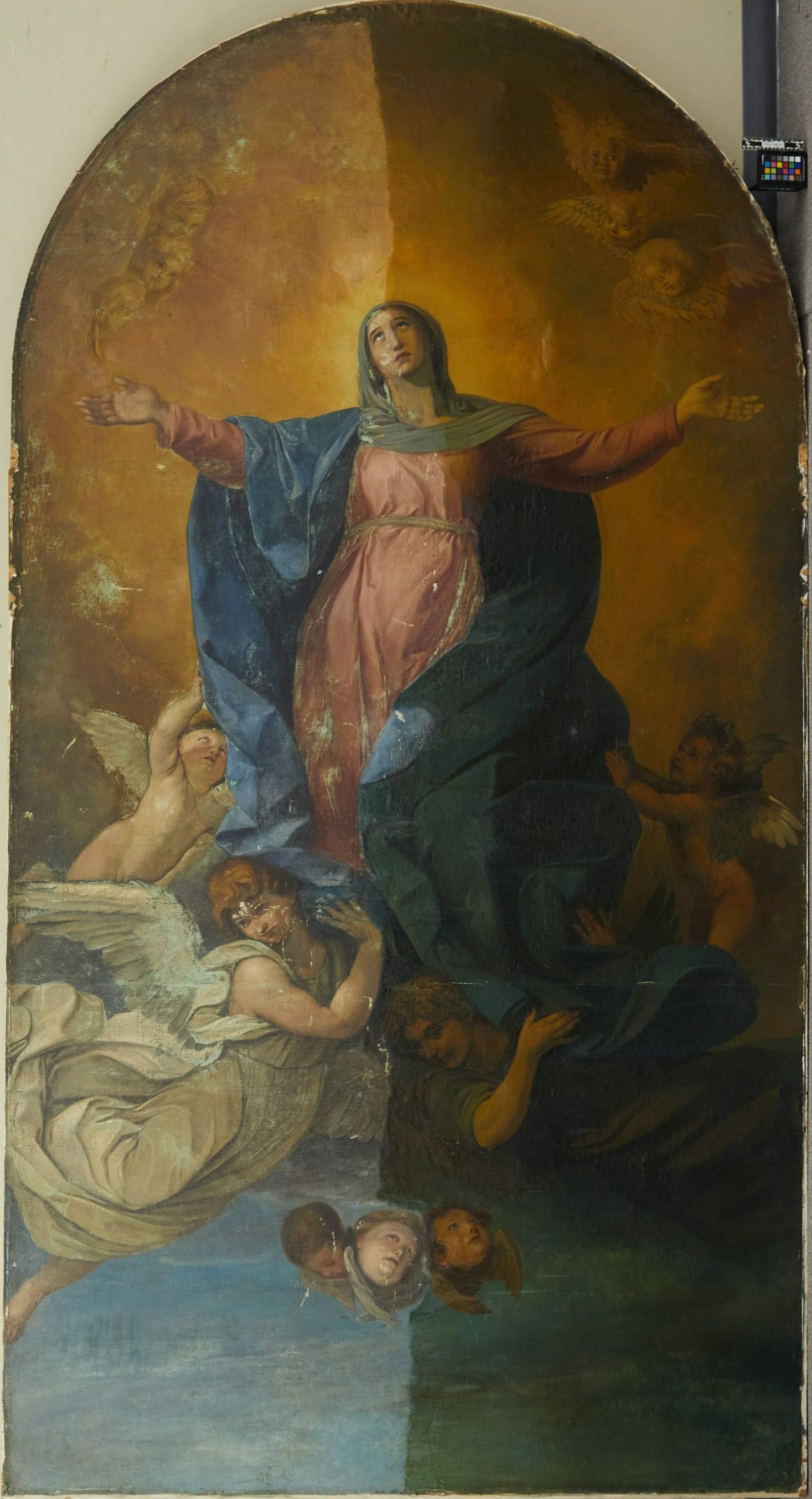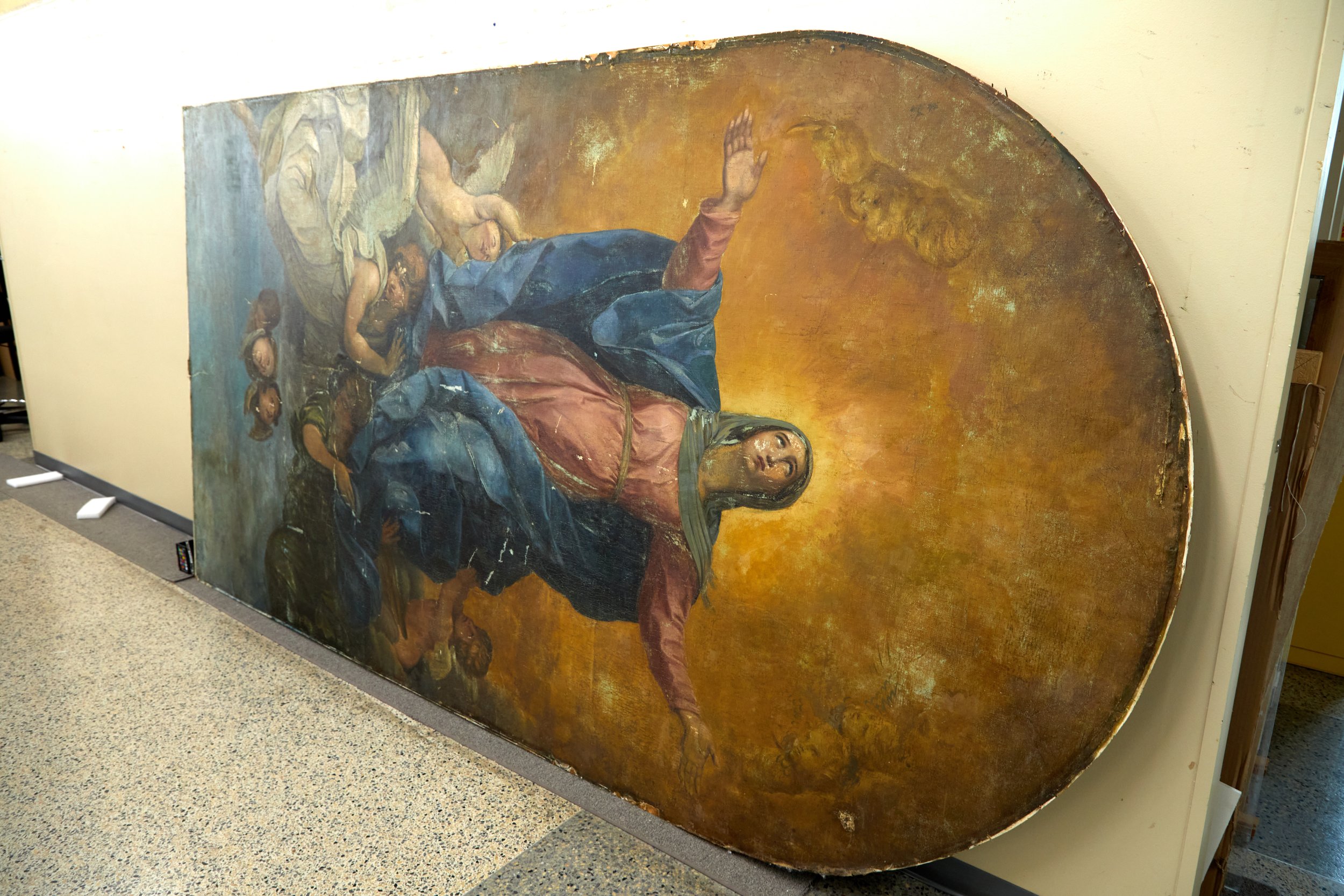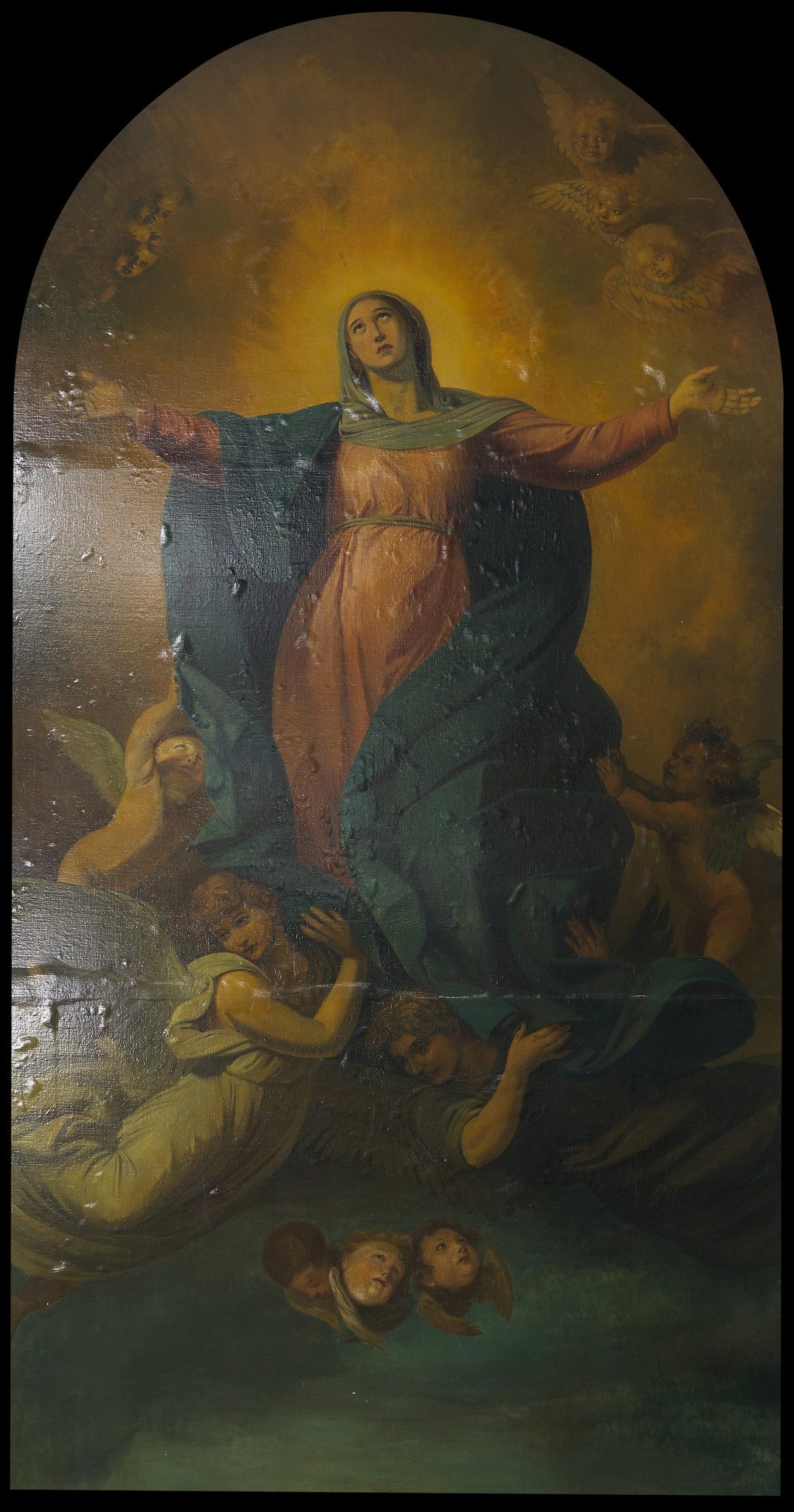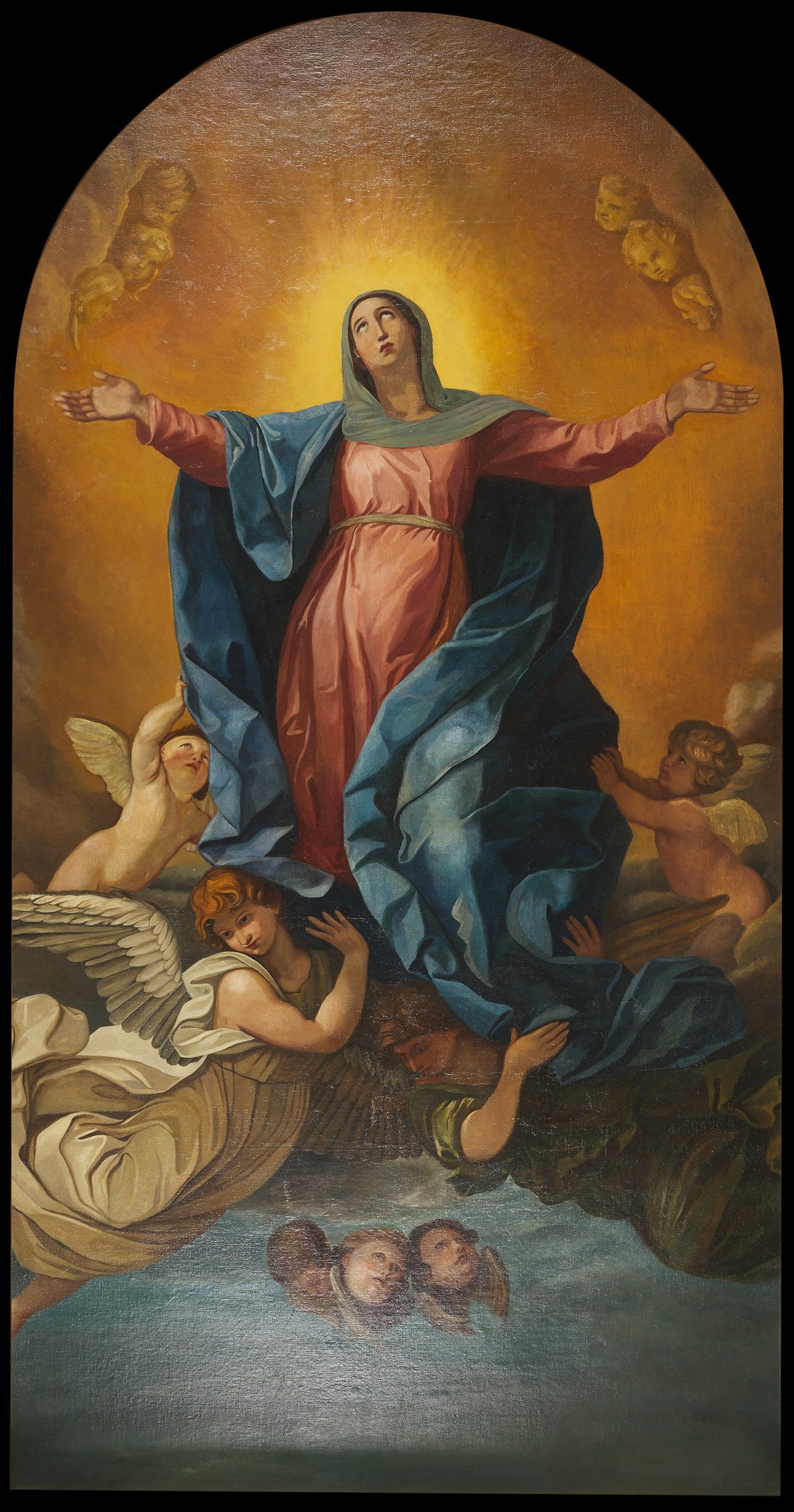The Assumption of Mary before treatment, shown over four images to capture its size and detail.
In August 2022, we shared the first stages of treatment of "The Assumption of Mary," a nine-foot-tall painting from St. Anthony Catholic Church in Davenport, Iowa. Nearly a year has passed since the treatment journey began, involving hundreds of hours of work. We are excited to present the final chapter of this enthralling painting's conservation tale.
The Assumption of Mary during treatment
The Assumption of Mary presents a striking and compelling portrayal of the event from which it draws its name: Mary's ascent into heaven. This mesmerizing artwork exudes a sense of vibrant motion and vitality. However, accumulated grime, discolored varnish, and inconsistent retouching marred the painting's true essence over time.
Detail of cherubs during surface cleaning
During phase one of the painting conservation, the surface was cleaned to remove grime, varnish, and repaint. The painting had expansive areas of liberally applied repaint that no longer matched. The painting also had a natural resin varnish discolored to yellow, with a moderate layer of grime. The transformation of the colors was magnificent, and details were revealed throughout the painting.
The Assumption of Mary during treatment, after surface cleaning.
The Assumption of Mary during treatment, after surface cleaning, shown over four images to capture its size and detail.
Phase two of the painting conservation began with removing the canvas from the board support. The removal of the painting was a collaborative effort involving both the Painting Department and the Custom Framing Department, who worked together to mechanically detach the canvas due to its large size. Then, the back of the canvas was mechanically cleaned with scalpels to remove excess adhesives and panel remnants. Next, Senior Paintings Conservator Amber Schabdach and Associate Paintings Conservator Rebecca Vodehnal applied BEVA 371 adhesive to the back of the canvas to line the canvas with a secondary lining fabric and honeycomb panel.
The canvas verso after removal from the support board.
Detail of the canvas verso
Now on the new support, areas of loss to the painting could be filled with conservation materials. Then, a layer of isolating varnish was applied to separate the original paint layer from the inpainting, then carried out with conservation-grade paints. The final step was a final varnish layer to integrate the surface finish. Due to the size of the painting, this was hundreds of hours of work.
The Assumption of Mary during inpainting.
Senior Paintings Conservator Amber Schabdach shared that the treatment is a slow and time-intensive process. "This project took all hands-on deck for many stages of the treatment. It was larger than our hot table and also didn't fit well into our spray booth, so many inventive decisions were made. It was with us quite a long time, as the treatment occurred over many, many months, but seeing the end result of the painting paired with its original restored frame was very satisfying."
Historic image of the alter at St. Anthony Catholic Church.
The frame and painting had been separated for decades. The painting arrived in Iowa from Belgium in 1892 and hung above the high altar for 50 years. During the 1940s, the church was renovated, and the painting was incorporated into the altar without the frame. The painting remained above the altar for decades; in fact, a massive fire engulfed the church on Christmas Eve 1947, and the painting was sent to Chicago to be restored shortly after that before being reinstalled above the altar. The frame was stored in the attic until being rediscovered only a few years ago.
The Democrat Newspaper, December 24, 1947
The alter at St. Anthony Catholic Church
The frame consists of three parts, designed as an engaged frame. Just like the painting surface, the frame suffered from discoloration. Years of grime accumulation and attic debris had taken their toll, robbing the gilded frame of its former brilliance. The inscription along the top, once a striking black on gold, had faded due to the effects of time. The thick layer of dirt and grime contributed to a mottled appearance, further detracting from its original grandeur.
Frame section found in storage.
Frame section found in storage.
Frame section found in storage.
Michael Young, Senior Paintings Conservator, and Associate Conservator Andrew Rigsby joined forces to restore this distinctive frame. Their first step involved consolidating any loose elements, addressing areas of loss, and dealing with lifting gesso, ensuring the frame's surface was stable before proceeding with cleaning. Once the preparations were complete, the intricate process of surface cleaning the carved elements commenced. Carefully employing suitable aqueous solutions, they skillfully removed the accumulated grime, unveiling the brilliance of the underlying gold leaf.
Right proper side of the frame, before treatment
Left proper side of the frame, before treatment
Detail image of the frame before treatment. Note the mottled surface
Detailed image of the frame before treatment
During treatment, this video features the surface cleaning of the frame
During treatment, this video features the surface cleaning of the frame
During treatment, this video features the surface cleaning of the frame
The restoration journey of "The Assumption of Mary" has been a testament to the dedication and expertise of the conservators involved. The conservation process has been a collaborative endeavor, with specialists from different departments coming together to overcome challenges posed by the painting's size and intricacy. Over a year and with countless hours of meticulous work, the painting and its long-forgotten frame have been reunited, uniting elements that had been separated for decades.
The Assumption of Mary after treatment, shown over four images to capture its size and detail.
The Assumption of Mary after treatment
Verso of The Assumption of Mary after treatment, with art handlers for scale!



